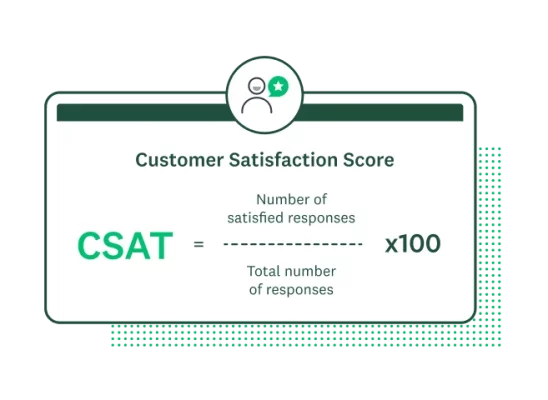CSAT vs NPS: which customer satisfaction metric to use
Learn how to use CSAT and NPS to fine-tune customer feedback programs. Review best practices for applying each metric throughout the customer journey.

Customer Satisfaction Score (CSAT) and Net Promoter Score® (NPS®) are key metrics for assessing customer experiences. CSAT measures customer satisfaction with specific services or products, while NPS tracks customer loyalty through recommendations.
Companies often combine CSAT and NPS metrics into Voice of the Customer (VoC) programs to enable precise tracking of customer sentiments and trends. This direct feedback informs strategic decisions, helping to refine your customer experience strategy effectively and efficiently.
What's the difference between CSAT and NPS?
Customer Satisfaction Score (CSAT) measures a customer's immediate satisfaction with a product, service, or interaction. Companies usually aim to capture customer [feedback] right after they engage with them, allowing them to gauge and respond to feedback quickly.
Net Promoter Score (NPS) assesses customer loyalty and the likelihood that a customer would recommend a company to others. It provides a broader view of customer sentiment over a longer period of time, indicating the overall health of customer relationships and brand perception.
CSAT captures in-the-moment feelings, while NPS reflects an ongoing commitment to your company. Both are crucial for understanding your customer experience. A satisfied customer may not necessarily be a loyal advocate.
How to calculate CSAT and NPS
How to calculate CSAT
To calculate your CSAT score, count the total number of satisfied (ratings of 4) and very satisfied (ratings of 5) customers, then divide by the total number of survey responses. Multiply by 100 to get the percentage.

What’s a good CSAT score?
A good CSAT score typically exceeds 80%, indicating high customer satisfaction. However, this benchmark varies across industries, with sectors like full-service restaurants averaging around 80%, while internet service providers might average only 64%.
How to calculate NPS
You calculate NPS by subtracting the percentage of detractors (customers who score 0-6) from the percentage of promoters (customers who score 9-10).

What is a good NPS score?
An NPS score above 0 is generally positive, but a score above 50 is excellent, and above 70 is considered world-class. However, these standards can vary significantly by industry.
SurveyMonkey Benchmarks is an excellent resource for measuring your CSAT and NPS performance against global averages across many industries.
CSAT vs. NPS: What CX metric should you use?
Choosing between CSAT and NPS is about understanding which fits your needs at different customer journey points. Both metrics offer unique insights that, when combined, provide a comprehensive view of customer experience and loyalty.
When to use CSAT
Deploy CSAT surveys to gauge immediate reactions to specific interactions or products. For example, after a customer support call, you might send a CSAT survey to assess satisfaction with the service received. This metric helps pinpoint areas needing quick fixes or immediate attention.
When to use NPS
Use NPS to measure broader sentiment and long-term loyalty across your customer base. This survey is typically not tied to any particular interaction, making it ideal for periodic evaluations that reflect the overall health of customer relationships. Companies often deploy NPS surveys quarterly to gauge the strength of their brand loyalty and customer advocacy.
How to integrate CSAT and NPS
To integrate CSAT and NPS effectively, start by using CSAT to address specific, immediate customer interactions and NPS to gauge long-term loyalty and overall sentiment. Analyze both sets of data to identify how short-term satisfaction influences long-term loyalty.
For example, an online retail store might use CSAT to refine various touchpoints (checkout, delivery, customer service, etc.) while employing quarterly NPS to assess overall brand loyalty among shoppers, ensuring that improvements in specific interactions contribute to lasting customer relationships.
How to build effective VoC Programs with CSAT and NPS
Creating an effective VoC program involves strategically using CSAT and NPS to capture insightful feedback that drives better business decisions. These tools allow you to measure and improve customer experience by focusing on immediate satisfaction and long-term loyalty.
Designing a VoC program that delivers
Start by defining clear objectives for your VoC program—what customer insights do you need, and how will they drive strategic actions?
Utilize CSAT to get quick feedback on direct customer interactions, such as after a purchase or customer service call. This metric helps identify immediate areas for improvement.
Use NPS to measure overall customer sentiment and loyalty over extended periods. NPS helps understand broader trends and predict customer behavior.
Both metrics should align with overarching business goals, ensuring every piece of feedback contributes to a strategic purpose.
Integrating relational and transactional metrics
To harness the full potential of CSAT and NPS:
- Integrate both relational and transactional metrics into your VoC program.
- For CSAT, focus on transaction-specific questions that gauge satisfaction at various touch points across the customer journey.
- For NPS, broader relationship-based questions should be incorporated to reflect the customer's brand perception.
This dual approach lets you capture detailed feedback on specific experiences while tracking general feelings toward your company over time. Analyzing how these metrics interact can reveal deeper insights, helping to refine customer experience strategies and drive meaningful business outcomes.

Best practices to use CSAT and NPS scores effectively
By implementing these practices, you can maximize the effectiveness of your CSAT and NPS metrics, turning customer feedback into actionable insights that drive business success.
Ask follow-up questions
Follow-up questions are an opportunity to understand the why behind CSAT and NPS scores. Always include a follow-up question in your surveys. For a CSAT question, you might ask, "What could we do better?" For NPS, try, "What do you enjoy about our service?" This strategy pinpoints precisely what to improve or continue doing.
Tie your CSAT and NPS results to meaningful action
Link survey responses to specific actions within your Customer Engagement Tools (CEM). For example, the SurveyMonkey and Salesforce integration lets you automatically trigger surveys and implement measures to prevent churn. This action ensures timely resolutions and shows customers that their feedback leads to real change.
Don't coast on good marks
High satisfaction in one area doesn't imply overall happiness. Scrutinize even high scores to discover underlying issues or missed expectations. Maintain a proactive stance, always looking for improvement.
Segment your metrics for deeper insights
Segment CSAT and NPS data by customer type, product line, or service area. This approach reveals nuanced insights and helps tailor strategies to specific segments, enhancing the effectiveness of your interventions.
Set the right goals for your team
Use CSAT to set specific performance goals for teams or individuals in direct customer service roles. Avoid using NPS as a metric for individual performance since it reflects broader, company-wide perceptions and may not accurately represent an individual's impact.
Drive business success with CSAT and NPS surveys from SurveyMonkey
CSAT and NPS are invaluable metrics for gauging customer satisfaction and loyalty. They provide insights that help fine-tune your customer experience strategies. These metrics are crucial in shaping compelling Voice of the Customer (VoC) programs that capture and act on customer feedback across various touchpoints.
Harness the power of these insights with expert CSAT and NPS survey templates from SurveyMonkey. Start measuring customer satisfaction with SurveyMonkey today and turn feedback into growth.
NPS, Net Promoter & Net Promoter Score are registered trademarks of Satmetrix Systems, Inc., Bain & Company, and Fred Reichheld.
Discover more resources

Customer satisfaction survey templates
Explore our customer satisfaction survey templates to rapidly collect data, identify pain points, and improve your customer experience.

3 ways to boost business growth by connecting SurveyMonkey and HubSpot
See how users are taking action on survey data to improve customer experience with the SurveyMonkey app for HubSpot.

How to use Forms to enhance your survey experience
How do surveys and forms differ? Learn how to combine form data with survey feedback for seamless events and experiences.

Beyond CX: How SurveyMonkey + Salesforce turn feedback into revenue
SurveyMonkey + Salesforce turn feedback into revenue